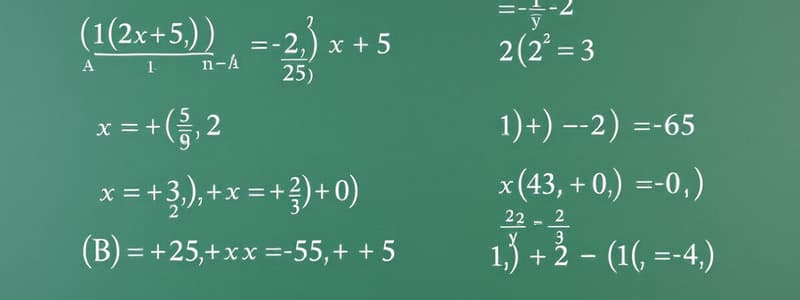Podcast
Questions and Answers
What is the purpose of the change of base formula?
What is the purpose of the change of base formula?
- To determine the slope of a line
- To calculate the area of a circle
- To change a logarithm with one base to a logarithm to another base (correct)
- To find the maximum height of a projectile
What is the equation of a circle?
What is the equation of a circle?
(x-h)²+(y-k)²=r²
What is the formula for compound interest?
What is the formula for compound interest?
A=P(1+r/n)^(nt)
What is the half-life formula?
What is the half-life formula?
What is the doubling formula?
What is the doubling formula?
What is the formula for growing or compounding continuously?
What is the formula for growing or compounding continuously?
What is the exponential decay formula?
What is the exponential decay formula?
What is the exponential growth formula?
What is the exponential growth formula?
What is the sine of an angle θ represented as?
What is the sine of an angle θ represented as?
What is the cosine of an angle θ represented as?
What is the cosine of an angle θ represented as?
What is the tangent of an angle θ represented as?
What is the tangent of an angle θ represented as?
What is the cosecant of an angle θ represented as?
What is the cosecant of an angle θ represented as?
What is the secant of an angle θ represented as?
What is the secant of an angle θ represented as?
What is the cotangent of an angle θ represented as?
What is the cotangent of an angle θ represented as?
Is sin θ/cos θ equivalent to tan θ?
Is sin θ/cos θ equivalent to tan θ?
Is cos θ/sin θ equivalent to cot θ?
Is cos θ/sin θ equivalent to cot θ?
What is the average rate of change formula?
What is the average rate of change formula?
What is the period equation?
What is the period equation?
What is a reference angle?
What is a reference angle?
What is amplitude?
What is amplitude?
What is the midline in relation to a periodic function?
What is the midline in relation to a periodic function?
Is a negative angle generated by a clockwise rotation?
Is a negative angle generated by a clockwise rotation?
Is a positive angle generated by counterclockwise rotation?
Is a positive angle generated by counterclockwise rotation?
What is a phase shift?
What is a phase shift?
What is frequency?
What is frequency?
Flashcards are hidden until you start studying
Study Notes
Logarithmic and Exponential Formulas
- Change of Base Formula: Transforms logarithmic expressions from one base to another for easier calculations.
- Compound Interest Formula: Used to calculate accumulated interest on an investment; expressed as ( A = P(1 + \frac{r}{n})^{nt} ), where ( A ) is the amount, ( P ) the principal, ( r ) the interest rate, ( n ) the number of times interest is compounded per year, and ( t ) the number of years.
- Half-Life Formula: Determines the remaining quantity after a certain time based on its half-life; given by ( y = C (1/2)^{t/h} ), where ( C ) is the initial amount, ( t ) is time, and ( h ) is the half-life duration.
- Doubling Formula: Describes exponential growth, indicating that quantity doubles over time; modeled as ( y = C (2)^{t/T} ), where ( C ) is initial amount, ( t ) is time, and ( T ) is doubling time.
- Continuous Growth Formula: Represents growth compounding continuously, formulated as ( A = Pe^{rt} ) with ( P ) as the initial investment, ( r ) the growth rate, and ( t ) time.
- Exponential Decay Formula: Used in contexts of decline; represented by ( y = C (1 - r)^{t/T} ) where terms follow as in previous formulas.
- Exponential Growth Formula: Indicates growth based on fixed intervals, given as ( y = C (1 + r)^{t/T} ) following similar variables.
Circle and Trigonometric Concepts
- Equation of a Circle: Standard form is ( (x-h)^2 + (y-k)^2 = r^2 ); defines a circle with center ( (h, k) ) and radius ( r ).
- Trigonometric Functions:
- Sine: Defined as ( \sin θ = \frac{y}{r} ).
- Cosine: Defined as ( \cos θ = \frac{x}{r} ).
- Tangent: Expressed as ( \tan θ = \frac{y}{x} ).
- Cosecant: Inversely related to sine; ( \csc θ = \frac{r}{y} ).
- Secant: Inversely related to cosine; ( \sec θ = \frac{r}{x} ).
- Cotangent: Inversely related to tangent; ( \cot θ = \frac{x}{y} ).
Trigonometric Identities
- Tangent Identity: ( \tan θ = \frac{\sin θ}{\cos θ} ).
- Cotangent Identity: ( \cot θ = \frac{\cos θ}{\sin θ} ).
Additional Concepts
- Average Rate of Change: Calculated as the ratio of the change in ( y ) to the change in ( x ).
- Period Equation: Represents the duration of one complete cycle in periodic functions, given by ( \text{Period} = \frac{2π}{\text{frequency}} ).
- Reference Angle: The acute angle formed between the terminal side of an angle in standard position and the x-axis.
- Amplitude: Maximum height of a wave's crest from its midline.
- Midline: A horizontal axis serving as a reference for the oscillation of periodic function graphs.
- Negative Angle: Refers to angles measured in a clockwise direction.
- Positive Angle: Refers to angles measured in a counterclockwise direction.
- Phase Shift: A horizontal displacement in the graph of a periodic function.
- Frequency: The count of complete waves passing a specific point in a designated time frame.
Studying That Suits You
Use AI to generate personalized quizzes and flashcards to suit your learning preferences.




